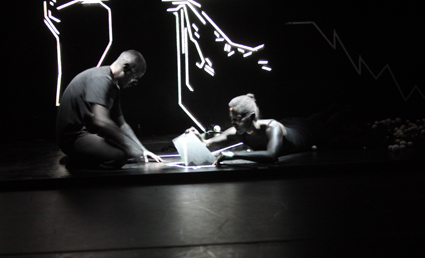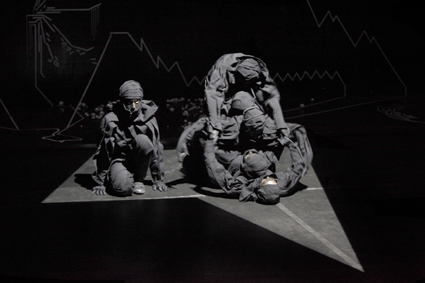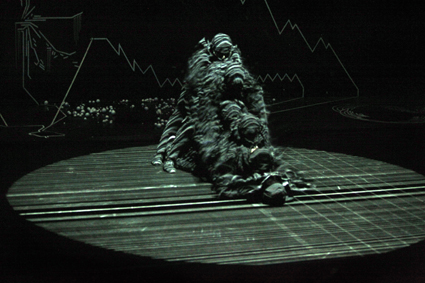blacker than black
keith gallasch: antony hamilton, black projects 1 & 2

Antony Hamilton, Melanie Lane, Black Project 1
photo Ponch Hawkes
Antony Hamilton, Melanie Lane, Black Project 1
ENTANGLED, ASLEEP IN THE STREET, A MAN AND WOMAN SLOWLY WAKE TO THE SOUND OF PERPETUAL DOWNPOUR AND RACKING STORM, CLOUDS WASHING OVER THE WALL AND THE ROAD THEY MOMENTARILY OCCUPY. THESE SILVERY, CHARCOAL BURNISHED CREATURES ESCHEW CONVENTIONAL HUMAN MOVEMENT AND INTIMACY FOR RITUALISTIC SYNCHRONICITY AND STRANGE SIGNALLING.
Squatting, arms swinging wide, mirroring each other, the pair gradually reach for two small spray cans to rapidly mark out, in brilliant white, circles on the ground around them and tribalistic lines across their faces. A mechanistic ritual of preparation appears to be complete.
What ensues is the furious making of a piece of art the length of the wall. In a curious inversion of the graffiti method, as if seen on a film negative, the pair peel away strips from the gritty, grey surface to reveal bright white lines, short and long, creating an abstract mural around two blank spaces that represent the artists’ temporary presence, subsequent absence and anonymity. Breaking the formality of their design, the two dribble fine lines of white paint down the wall, loosening the relative tightness of their composition.
In a final gesture, the graffiti becomes three-dimensional as the pair lift a piece of the footpath away, take out rolls of white tape and extend the lines on the wall to the ground. Carefully extricating themselves, they move to the far side of their creation where—kneeling, arms extended, gesturing at and contemplating their creation—they disappear.
More than romanticising graffiti artists, Black Project 1, not unlike Lucy Guerin’s masterwork, Structure and Sadness (2006), is about the making of art—preparation, teamwork, process, completion, albeit in a setting more post-apocalyptic than contemporary. In Structure and Sadness, the creation collapses; here it remains, the residue of lives and the art instinct, a momentary three-dimensional habitat. Light pulses across it, reshaping the depth of field, giving the work a life of its own while recalling the astonishing movement and intricacies of gesture that created it.
Black Project 1 bleeds into number 2, the artwork fading to background and the storm to an insistent drumroll pitched against massive creaking and straining as we find ourselves in another dimension of Hamilton’s black world.
Instead of the unpredictable lines of the graffiti-ists, a large, projected triangle draws our attention to the downstage floor where, paralleling the open sing of Black Project 1, lie six tangled bodies, but here as an amorphous lump, indiscernibly human. If the solo performer in Gideon Obarzanek’s Glow (2006) represented an emergent organism on a dark voyage into humanity, this cluster is a cellular creature of another kind if likewise gridded by changing geometries of light—the triangle morphs into much else as the creature writhes, ravenously devours parts of itself, mutates into a many headed monster and splits into two halves. It’s a Rorschach-cum-mirror-neuron image of great power and meticulous execution: the grimness of the imagery and the almost total absence of any sense of the individual suggest devolution rather than evolution, or perhaps post-apocalyptic, mutant humanity starting out again.

Black Project 2, Antony Hamilton
photo Ponch Hawkes
Black Project 2, Antony Hamilton
As in Black Project 1, creativity appears to be at the core of this project. The creature bears down heavily on each part of itself, but is capable of huge bursts of energy. It’s like the dancing of Thriller, but eons on, morphed with breakdancing and more. And finally, it reveals another capacity. Collapsing back into itself, overlaid once more with the projected triangle, the creature lifts small metallic triangles aloft and, squirming, shapes them into a tiny pyramid at the front of the stage. The creature breaks into its component parts in a line at the base of the triangle, each member bowed low as if in prayer or adoration. The pyramid glows red.
With its final image of submission and worship, the act of creativity in Project 2 is certainly darker and more ambiguous than the one in Project 1. The provenance of the crafted, metal triangles is much more opaque than that of the humble materials of Project 1. The result is more abstract, and the pyramid, like the monolith in 2001: A Space Odyssey, hints at things cosmological—things beyond Earth and evolution that have perhaps shaped us—be they the legacy of alien overlords or creationism’s intelligent design. But there’s an element of pathos in Project 2’s ending—the pyramid is so small and the makers’ abjection so total. And there is no curtain call, so determined is the choreographer to sustain the final image and make its grim reality part of ours.
I saw Black Project 1 in Sydney Opera House’s 2010 Spring Dance (RT111). It has stayed with me indelibly, not least as an intense painterly experience. It was strange to see it again, to know and not know it and to be enveloped again by its multitudinous shades of black and grey. Project 2, impressively costumed by Paula Levis so that bodies magically meld and the metallic sheen of mask-like faces is glimpsed only now and then, is at its most powerful in its central realisation of the movement of a mutant organism. It writhes, divides, reforms, evoking cellular life and pop culture memes that connect it with our own time in a future where the capacity to create and worship, for good or bad, lives on.

Black Project 2, Antony Hamilton
photo Ponch Hawkes
Black Project 2, Antony Hamilton
Project 2 certainly doesn’t feel as complete as Project 1, its big idea not altogether as clear nor as potent as the humble agency and creativity of the artists that is central to the first work, where we could feel our own world more palpably present. Black Project 2 is a powerful and exacting work, if at times over-extended and so resolutely black—although I do recall a tiny dance of many hands at the tip of the triangle that evoked a rare moment of intimacy and playfulness. I hope Black Project 2 sooner or later evolves to become the equal of its partner. Even so, Hamilton’s is a distinctive vision, acutely realised and choreographically rich.
Dance Massive: Arts House and Antony Hamilton Projects, Black Projects 1 & 2, choreography, concept Antony Hamilton, Black Project 1: performers Antony Hamilton, Melanie Lane, video projection Olaf Meyers, music Robert Henke, Mika Vainio and Vainio and Fennesz, design Antony Hamilton; Black Project 2: performers James Batchelor, Jake Kuzma, Talitha Maslin, Jessie Oshodi, Marnie Palomares, Jess Wong, costume design Paula Levis, sound designer Alisdair Macindoe, video design Kit Webster, set construction, production Management Matthew Scott, Megafun, producer Freya Waterson, Insite Arts; Arts House, Meat Market, Melbourne, March 12-16; http://dancemassive.com.au/
RealTime issue #114 April-May 2013 pg. 32






